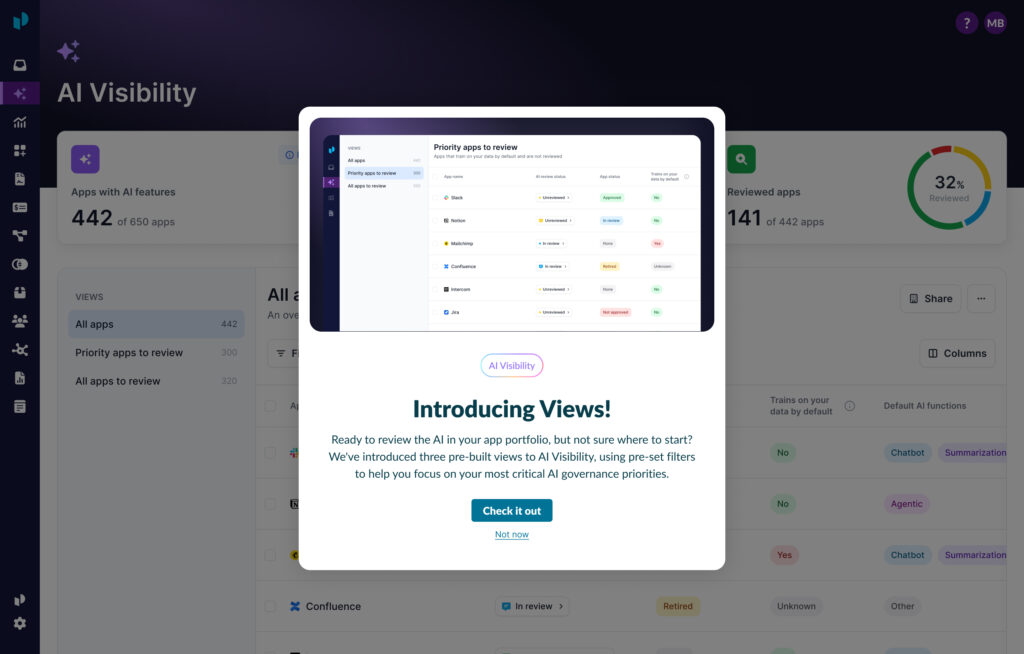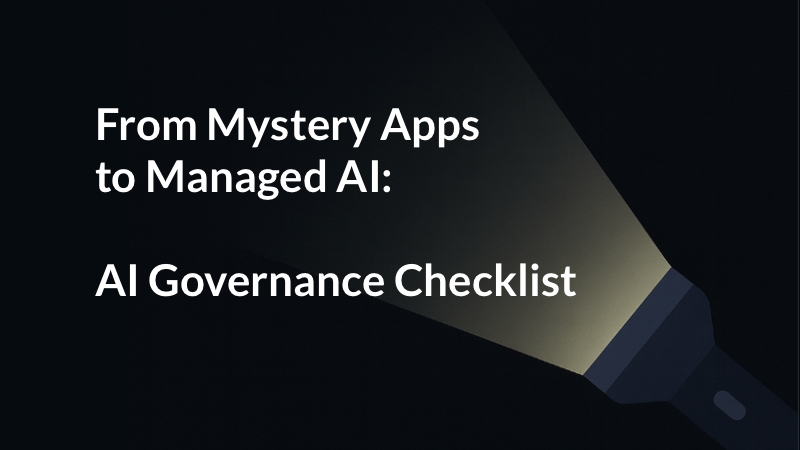
What is a Software License Agreement?
As the SaaS ecosystem continues to expand, organizations are consistently challenged to optimize their SaaS investments. In fact, 30% of software licenses are never used, and another 8% are rarely used (less than once a month), according to a study by G2, creating a difficult hurdle for businesses looking to increase their software ROI.
Understanding how to read and when you use a Software License Agreement is now more important than ever. Businesses need to understand the key components, benefits, and risks of not having a SLA management strategy in place. By implementing key best practices, organizations can achieve cost savings, mitigate legal risks, and enhance overall IT efficiency.
What is a Software License Agreement?
A Software License Agreement (SLA) is a legal contract that outlines the terms and conditions for using software. It’s essentially a permission slip from the software creator to the user, specifying how the software can be used, how many users or devices it can be installed on, and any restrictions on modification or distribution. The SLA also typically covers warranties, support options, and liability in case of issues. In essence, it defines the rights and responsibilities of both the software provider and the user.
What is the purpose of a Software License Agreement?
When it comes to managing SaaS, an SLA serves as a contractual framework governing the relationship between a SaaS vendor and its customer. It outlines the terms and conditions for accessing and utilizing the cloud-based software, including the scope of services, pricing, payment terms, service level agreements (also commonly referred to as SLAs), data privacy, and intellectual property rights. Understanding and managing these agreements is crucial for optimizing software investments, mitigating risk, ensuring compliance, and maximizing the value derived from SaaS applications.
When do I need a Software License Agreement?
Teams often use SLAs to establish a clear contractual framework for software acquisition and usage. They are relied upon to define pricing, payment terms, and vendor obligations, ensuring cost-effective deals.
IT and procurement will often collaborate on terms in order to negotiate SLAs that align with the organization’s needs, protect its interests, and minimize legal and financial risks. By carefully reviewing and managing SLAs, organizations can optimize software investments, ensure proper software utilization, and maintain a compliant software portfolio. Additional factors to consider include:
- Procurement and onboarding: When acquiring new SaaS applications, the team must carefully review SLAs to understand usage rights, pricing models, service levels, and potential liabilities.
- Contract negotiation: For enterprise-level agreements, SaaS managers often negotiate SLA terms to align with the organization’s needs, such as data privacy, security, and performance guarantees.
- Vendor management: Ongoing management of SaaS contracts requires understanding SLA terms to ensure compliance, optimize costs, and address potential issues.
- Risk management: SLAs contain critical information about data ownership, security, and liability, which are essential for assessing and mitigating risks.
- Compliance: Adhering to industry regulations often involves understanding and fulfilling obligations outlined in SaaS contracts.
- Cost optimization: Analyzing SLA terms helps identify opportunities for cost savings, such as negotiating discounts or consolidating licenses.
SLAs are the foundation for managing SaaS relationships effectively, and a deep understanding of their contents is crucial for SaaS management success.
What do Software License Agreements cover?
A comprehensive SLA can vary depending on the type of software, but will generally outline the terms and conditions of use in the following key areas:
User rights and obligations
- Grant of license: Specifies the rights granted to the user, such as the right to install, use, and access the software.
- Permitted use: Defines how the software can be used, including the number of users, devices, or concurrent users.
- Restrictions: Outlines prohibited activities, such as modifying, copying, distributing, or reverse engineering the software.
- Intellectual property rights: Clarifies ownership of the software and any related intellectual property.
Payment and licensing terms
- License fees: Details the cost of the software, payment terms, and renewal options.
- Licensing model: Specifies the type of license (perpetual, subscription, usage-based, etc.) and its terms.
- Upgrades and updates: Outlines the availability and cost of software updates and upgrades.
Warranty and support
- Warranties: Specifies any warranties provided by the software vendor
- Support services: Describes the level of support offered, including contact information, response times, and support channels.
Limitation of liability
- Disclaimer of warranties: Limits the software vendor’s liability for damages caused by the software.
- Indemnification: Specifies which party is responsible for covering damages or losses.
Termination
- Termination conditions: Outlines circumstances under which the agreement can be terminated by either party.
- Survival clauses: Specifies which provisions of the agreement continue to apply after termination.
Dispute resolution
- Governing law: Determines which jurisdiction’s laws apply to the agreement.
- Dispute resolution: Specifies the method for resolving disputes, such as arbitration or mediation.
It’s important to note that the specific terms of an SLA can vary widely depending on the type of software, licensing model, and the relationship between the software provider and the user.
What are the limitations of Software License Agreements?
While Software License Agreements are essential for protecting the rights of both software providers and users, they do have limitations.
Enforceability challenges
- Complex legal landscape: The rapidly evolving SaaS landscape often outpaces legal frameworks, making it difficult to enforce certain provisions.
- Jurisdictional issues: Disputes may arise regarding which jurisdiction’s laws apply, especially in cross-border transactions.
- Proof of breach: Demonstrating a breach of contract can be complex, particularly for issues related to software performance or intellectual property infringement.
Limited protection for users
- One-sided nature: SLAs often favor the software provider, with limited protections for users.
- Unfair terms: Some SLAs may contain terms that are overly restrictive or disadvantageous to users.
- Lack of clarity: Ambiguous language or unclear terms can lead to misunderstandings and disputes.
Technological limitations
- Rapid evolution: SaaS is constantly evolving, making it challenging for SLAs to keep pace with new developments.
- Unforeseen issues: SLAs may not adequately address emerging challenges such as cybersecurity threats or data privacy concerns.
Enforcement costs
- Legal proceedings can be expensive and time-consuming, making it difficult for individuals or small businesses to enforce their rights under an SLA.
It’s important to note that while SLAs have limitations, they remain crucial tools for managing software relationships. By understanding these limitations, you can better work with your vendors to create more balanced and effective agreements.
How to effectively manage Software License Agreements
Effective software license management is crucial for organizations to avoid legal and financial risks, optimize software investments, and ensure compliance.
1. Centralized software inventory
- Comprehensive listing: Maintain a detailed inventory of all software assets, including licenses, purchase dates, and expiration dates.
- Regular updates: Keep the inventory up-to-date with software installations, removals, and license renewals.
2. Understanding license terms
- Thorough review: Carefully examine each software license agreement to understand usage rights, limitations, and renewal terms.
- Documentation: Create clear summaries of key license terms for easy reference.
3. License Compliance
- Regular audits: Conduct periodic audits to ensure compliance with license terms and identify potential risks.
- Software usage monitoring: Track software usage to optimize license allocation and prevent overspending.
4. SaaS Management Platforms
- Leverage technology: Utilize a SaaS Management Platform to automate workflows, track SaaS usage, and generate reports.
- Data integration: A complete visual of your SaaS lifecycle can allow for better spend decisions.
5. Vendor management
- Strong relationships: Build strong relationships with software vendors to negotiate favorable terms and receive timely support.
- Contract negotiation: Carefully review and negotiate license agreements to protect the organization’s interests.
6. Employee training
- Awareness: Educate employees about the importance of software compliance and the potential consequences of misuse.
- Best practices: Provide guidelines for software installation, usage, and disposal.
7. Regular review and optimization
- License optimization: Analyze software usage data to identify opportunities for license consolidation or downsizing.
- Cost reduction: Implement strategies to reduce software costs, such as negotiating volume discounts or exploring alternative licensing models.
By following these steps, organizations can effectively manage their software licenses, reduce costs, mitigate risks, and ensure compliance with legal requirements to deliver maximum value to the organization.
About Productiv:
Productiv is the IT operating system to manage your entire SaaS and AI ecosystem. It centralizes visibility into your tech stack, so CIOs and IT leaders can confidently set strategy, optimize renewals, and empower employees.





